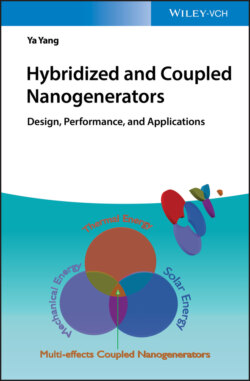Читать книгу Hybridized and Coupled Nanogenerators - Ya Yang - Страница 8
Forewords
ОглавлениеMaxwell's equations are fundamental key equations in physics, which are the foundation of modern wireless communication, light communication, and energy science. Nanogenerators (NGs) are based on utilizing Maxwell's displacement current as the driving force to effectively convert mechanical energy into electricity, regardless of whatever used materials are nano or not. To date, NGs have attracted extensive interest due to potential applications as self‐powered sensor networks, small power sources, and even large‐scale blue energy harvesting. Hybridized NGs are based on integrating different NGs into a system that can simultaneously/individually scavenge the different types of energies in our living environment, so that a stable and sustainable power supply can be obtained by using whatever energy is available in the environment. Since we reported the first hybrid NGs in 2009 (Chen Xu, Xudong Wang, and Zhong Lin Wang, Nanowire structured hybrid cell for concurrently scavenging solar and mechanical energies, JACS, 131, 2009, 5866–5872), a variety of NGs based on different structures have been demonstrated, including mechanical energy, solar energy, thermal energy, and even chemical energy. In recent years, hybridized NGs also include the integration of different NGs to scavenge the same type of energy but using different methods for largely enhancing the energy conversion efficiency. Part of this book will give a detailed summary about the design, performance, and applications of hybridized nanogenerators.
Zhong Lin Wang, Professor
Laureate of Albert Einstein World Award of Science
Laureate ENI award
Regents' Professor and Hightower Chair Professor
School of Materials Science and Engineering
Georgia Institute of Technology, USA
Director and Chief Scientist
Beijing Institute of Nanoenergy and Nanosystems, Chinese Academy of Sciences
Multifunctional materials have attracted more and more interest due to potential applications in energy scavenging units, sensors, and physical sciences. As one of the multifunctional materials, many ferroelectric materials have piezoelectric, pyroelectric, photovoltaic, and triboelectric effects, where the coupling among these effects is interesting. By utilizing these multifunctional materials, various one‐structure‐based coupled nanogenerators have been achieved to simultaneously or individually scavenge different energies from the living environment wherever and whenever any energy is available. The core of coupled nanogenerators is the multifunctional material, so that looking for the high‐performance materials is very important to realize the maximized complementary scavenging of multiple energies from the ambient environment. Moreover, coupled nanogenerators have potential applications in multifunctional sensors due to the use of the same materials and electrodes, resulting in higher resolution, smaller volume, and lower cost as compared with those of various integrated sensors reported for the simultaneous detection of multi‐physical signals. Some new physical effects such as thermo‐phototronic effect are based on the coupled nanogenerators, where the new coupling enhancement phenomenon has been found between the thermoelectric and photovoltaic effects in some semiconducting materials. Part of this book will give a detailed summary about the design, performance, and applications of coupled nanogenerators.
Yue Zhang, Professor
Department of Materials Physics and Chemistry
School of Materials Science and Engineering
University of Science and Technology Beijing, China
Member of the Chinese Academy of Sciences
